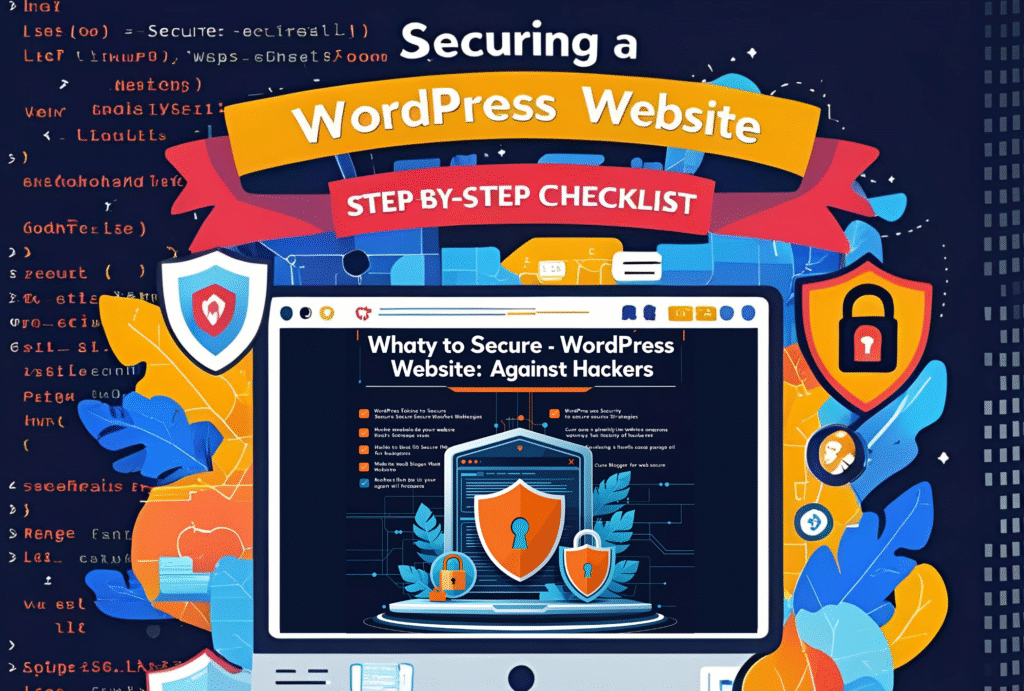In 2025, WordPress continues to dominate the CMS landscape, powering over 40% of all websites. While its popularity makes it a go-to platform for developers and businesses, it also makes WordPress a prime target for hackers. With cyberattacks growing in sophistication, ensuring robust security is no longer optional—it’s essential. In this comprehensive guide, we present a detailed developer’s checklist to secure your WordPress website against malicious threats.
Introduction: Why WordPress Security Matters in 2025
WordPress sites are frequently targeted due to their widespread use. From data breaches to ransomware attacks, the risks of operating an unsecured site include stolen data, damaged reputation, search engine penalties, and even legal consequences. In a time when data privacy is paramount, site owners must invest in proactive security measures to protect their digital assets.
1. Keep WordPress Core, Themes, and Plugins Updated
One of the most common entry points for hackers is outdated software. The WordPress core, themes, and plugins regularly release security patches that fix known vulnerabilities.
Best Practices:
- Enable automatic updates for minor WordPress releases.
- Regularly check and update plugins/themes manually or with a tool.
- Avoid using plugins/themes that are no longer maintained.
2. Use Only Trusted Themes and Plugins
Third-party plugins and themes can introduce security risks if they’re poorly coded or malicious.
Developer Tips:
- Download plugins and themes only from trusted sources like WordPress.org or premium vendors.
- Check reviews, update frequency, and active installations.
- Avoid using nulled or pirated versions.
3. Limit Login Attempts and Use Two-Factor Authentication (2FA)
Brute force attacks aim to guess login credentials through repeated attempts.
How to Secure It:
- Limit login attempts using plugins like Login LockDown or Limit Login Attempts Reloaded.
- Enable 2FA using Google Authenticator, Authy, or Duo.
- Apply 2FA for all admin-level users.
4. Strengthen Admin Credentials and URLs
Weak usernames and passwords are still one of the easiest ways into a site.
Steps to Improve Access Control:
- Avoid using “admin” as a username.
- Use strong, complex passwords with a password manager.
- Change the default login URL using plugins like WPS Hide Login.
- Disable user enumeration via functions.php or .htaccess rules.
5. Secure File Permissions and Disable Directory Browsing
Improper file permissions and open directories can expose sensitive information.
Recommended Permissions:
- Files: 644
- Folders: 755
- wp-config.php: 400 or 440
Additional Tips:
- Disable directory browsing by adding Options -Indexes to .htaccess.
6. Install a Robust WordPress Security Plugin
Security plugins provide real-time protection, malware scanning, and firewall rules.
Top Choices:
- Wordfence Security
- Sucuri Security
- iThemes Security
Features to Look For:
- Firewall integration
- Malware scanning
- IP blacklisting
- Login attempt monitoring
7. Enable Web Application Firewall (WAF)
A WAF filters malicious traffic before it reaches your website.
Types of WAFs:
- DNS-Level: Cloudflare, Sucuri
- Application-Level: Integrated in plugins like Wordfence
Benefits:
- Blocks SQL injections, XSS, and brute-force attempts
- Reduces server load
8. Implement SSL and HTTPS Site-Wide
An SSL certificate encrypts data between the server and the browser.
Why It Matters:
- Improves SEO rankings
- Secures login forms and transactions
- Builds trust with users
Setup Tools:
- Use Let’s Encrypt for free SSL
- Redirect HTTP to HTTPS via .htaccess or plugins like Really Simple SSL
9. Regular Backups: Your Last Line of Defense
Even with the best defenses, breaches can happen. Backups allow quick restoration.
Best Practices:
- Schedule daily or weekly backups
- Store backups offsite (cloud or external server)
- Test restore functionality periodically
Recommended Plugins:
- UpdraftPlus
- BlogVault
- Jetpack Backup
10. Monitor Logs and Enable Security Alerts
Log monitoring helps detect unusual behavior before it escalates.
What to Monitor:
- Login attempts
- File changes
- Plugin/theme installations
Tools to Use:
- WP Activity Log
- Logtivity
- Built-in security plugin alerts
11. Secure wp-config.php and .htaccess Files
These core configuration files control critical site settings.
How to Harden Them:
- Move wp-config.php one directory level up if possible
- Deny access via .htaccess:
<files wp-config.php>
order allow,deny
deny from all
</files>
- Similarly, protect .htaccess itself:
<files .htaccess>
order allow,deny
deny from all
</files>
12. Disable XML-RPC if Not Needed
XML-RPC enables external apps to interact with WordPress but is often exploited.
How to Disable:
- Use a plugin like “Disable XML-RPC”
- Block access via .htaccess:
<Files xmlrpc.php>
Order Deny,Allow
Deny from all
</Files>
13. Protect Against SQL Injection and XSS
Insecure input handling can open your site to severe vulnerabilities.
Development Practices:
- Sanitize and validate all user inputs
- Use prepare() method in database queries
- Escape output with esc_html(), esc_attr(), etc.
- Regularly test code using security linters and validators
14. Security Testing Tools and Vulnerability Scanners
Routine testing identifies risks before they become exploits.
Recommended Tools:
- WPScan
- Detectify
- Nessus
- Qualys SSL Labs (for HTTPS)
Tips:
- Run monthly scans
- Document and address all findings promptly
Conclusion: Build a Culture of Continuous Security
Securing a WordPress site isn’t a one-time task. Developers and agencies must adopt a proactive, continuous approach to security. By following this checklist, you create a hardened environment that discourages attackers and ensures business continuity.
Security should be embedded in every stage of your WordPress development lifecycle. Educate your team and clients, stay updated with threat intelligence, and never let your guard down. A secure website is not just a safe website—it’s a professional, trusted brand experience.
Looking for expert WordPress development services with enterprise-grade security? Contact our digital marketing agency today and let us help you build a safer, faster, and more scalable website.

